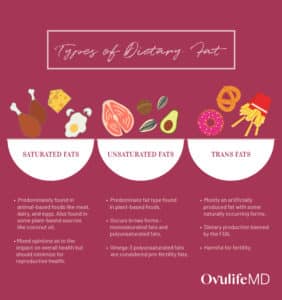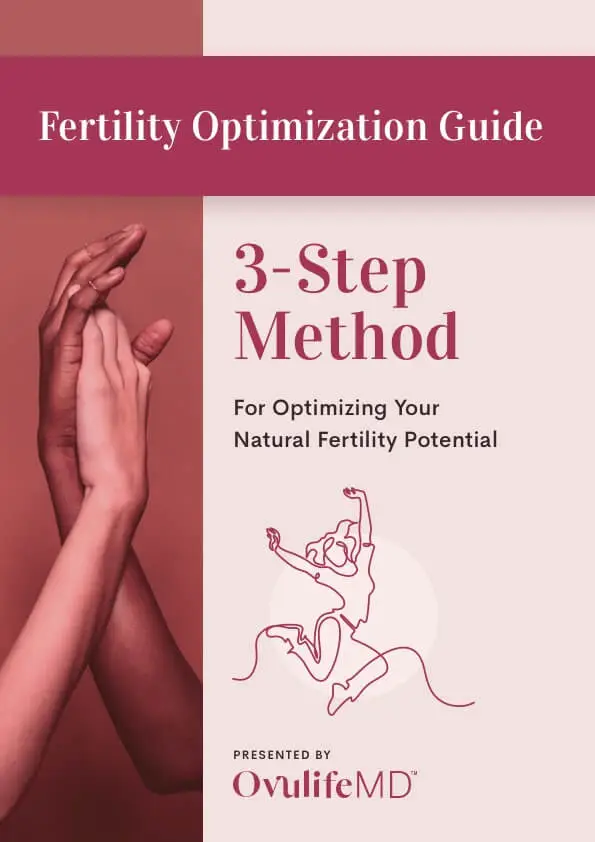
Sometimes science gets things wrong…
The demonization of fat was certainly a misguided step in the nutritional science world.
During the mid-twentieth century, people were advised to reduce their fat intake as it would lead to weight gain, increased body fat, and heart disease.
Part of the problem with the low-fat recommendation was that we did not fully understand the role that different dietary fats have in our bodies at the time.
Fats make up nearly every cell in our bodies and contribute to the formation of our hormones (e.g, estrogen & progesterone). Some fats promote inflammation and others help minimize it. More importantly, some forms of fat may improve ovulation and your odds of getting pregnant.
Let’s explore why you shouldn’t fear fats when trying to conceive.
Here’s a quick overview of what you’ll discover:
Why we need dietary fats
Despite getting a bad wrap for so long, there are many reasons to enjoy fat-containing foods.
First and foremost, fat plays a major role in hormone production (super important for when you’re trying to conceive…and for everyday health and wellness for that matter).
In addition to hormone production, fats help us to absorb nutrients like vitamins A, D, E, and K as well as other phytonutrients and antioxidants. As we discuss in The Fertility Superfoods Guide, these are just some of the nutrients contributing to optimal reproductive health.
Another reason why fats are so important is that they help balance blood sugar and dampen inflammation. If you recall from our post on carbohydrates, keeping blood sugar stable is crucial for regulating levels of insulin and inflammation within your body.
We’ll take a closer look at the fat and inflammation connection in just a moment… for now, just remember that the lower your inflammation levels, the better your odds of conceiving and giving birth to a healthy baby.
Beyond all the health-promoting benefits of good fats, they also keep us feeling full longer and provide us energy. And of course, they’re delicious!
How much fat is enough?
Fats typically make up the smallest percentage of calories in our diets, despite having a similar target intake as protein. For most individuals, fat intake should be between 20-35% of your total caloric intake.
One reason that some women shy away from fats is that they are the most calorically dense macronutrient, providing 9 calories per gram – twice as many as carbohydrates or proteins. This fact alone, in addition to the old adage that fat raises cholesterol and is bad for our health, still has some people second-guessing themselves when putting fat on their plates.
The real story behind low-fat and fertility
Sometimes you’ll read claims that low-fat diets are bad when trying to conceive.
Unfortunately, this statement is NOT entirely accurate based upon the scientific literature. According to research presented in the Fertility Diet book by Dr. Jorge Chavarro and Dr. Walter Willett, the amount of fat consumed by reproductive-age women has not been associated with infertility.
Interestingly, the Harvard researchers found that women who ate ≥ 2 servings of low-fat dairy (e.g., skim milk) per day had an 85% higher risk of ovulatory infertility compared to those who ate full-fat dairy products (e.g., whole milk). As we discuss in another post, this correlation is probably not related to the different forms of dairy being low-fat, but the hormones left behind as a result of skimming the full-fat milk.
Take-home point – don’t sweat the amount of fat in your diet, but there might be something about the type of fat that matters!
Why not all fats are made equal.
Plain-and-simple, some fats are more desirable than others.
To understand WHY we need to look at the different types of fat in our diet… We promise we’re getting to which fats matter for fertility in just a moment.
Just like carbs, dietary fats are often broken down into good fats and bad fats.
As we pointed out at the beginning of this article, we need fats for our body to function, so this isn’t necessarily the best classification. With that said, some forms of fat are healthier than others.
Let’s quickly take a look at the different types of fat.

Saturated Fats:
This fat group has been named as such because all of the carbon molecules are fully ‘saturated’ with hydrogen atoms. For those of you who hate biochemistry as much as most doctors, simply know that these fats don’t have a very flexible structure. This inflexible structure was part of the reason why saturated fats were believed to be so bad for our health, but we’re entirely sure about that anymore.
Saturated fats are most commonly found in animal proteins like red meat, poultry, dairy, and fish. Coconut oil is one of the better known plant-based saturated fats.
Unsaturated Fat:
In contrast to saturated fats, unsaturated fats are found in both animal and plant-based foods. They vary in the number of carbon molecules that are missing hydrogen atoms, resulting in two types of unsaturated fats – monounsaturated and polyunsaturated fats.
Monounsaturated fats have two fewer hydrogen atoms than saturated fats, which means they are liquid at room temperature. Good sources of monounsaturated fats are olive oil, avocados, and most nuts. Monounsaturated fats are greatly attributed to the health benefits of the Mediterranean diet.
Polyunsaturated fats are also referred to as essential fatty acids, meaning you can’t make them but your body needs them to function. There are two main types of polyunsaturated fats: omega-3 fatty acids and omega-6 fatty acids. The numbers just refer to the location of the double bonds in the molecules. Both offer health benefits, and it’s the relative ratio of the two fats that matters. When you eat more omega-6 than omega-3s in your diet, you can increase your levels of inflammation. Obviously, this is a bit simplified, but it’s what you need to know if you’re just learning how to nourish your body for optimal fertility.
Trans-Fat:
Trans-fats come in both natural and artificial forms. However, the majority of trans-fats are formed through an industrial process in which hydrogen atoms are added to vegetable oil to form a semi-solid product known as partially hydrogenated oil.
We won’t spend too much time on this topic here as the FDA finally banned this man-made fat in 2018 (all products containing trans fat are unlikely to be off the shelf in 2020 at the earliest). For now, just know that trans fats have been linked to a number of health issues including diseases such as cardiovascular disease, type 2 diabetes, and metabolic syndrome/obesity.
Trans fats can be found in many processed foods including deep-fried foods, doughnuts, pie crusts, and other pre-packaged baked goods including cookies and cakes as well as frozen pizza, margarine, and other spreads.
Ready to Remove Unhealthy Fats & Put the Fertility Diet Into Action?
Fats and fertility
Okay, it’s time to explore what type of healthy fats you should be eating when trying to conceive. And don’t worry, we’ll also point out the fats that you should avoid too!
Early research on the topic of fats and fertility was quick to discover that trans fats were significantly more likely to be associated with ovulatory infertility than were monounsaturated or polyunsaturated fats.
In fact, increasing caloric intake of TRANS FATS by just 2% over omega-6 polyunsaturated fats was associated with a 79% greater risk of ovulatory infertility. A similar but even more profound effect was noted when more trans fats were consumed in place of monounsaturated fats, which was just over double the risk of ovulatory infertility.
Beyond the risk for ovulatory infertility, women consuming trans fats have also been noted to have a 48% increased risk of having endometriosis. For those who do not struggle with endometriosis, it’s an inflammatory condition that leads to extremely painful menses as well as infertility. The interesting thing noted from this same study was that women with the highest intake of omega-3 fatty acids were 22% less likely to be diagnosed with endometriosis.
The idea that the quality of fat matters for fertility became even more apparent in the PRESTO study. In this study, women with the highest intake of omega-3 fatty acids had a 21% higher fecundability rate (i.e., the likelihood of conceiving in a given month) compared to those with the lowest intake. On the other hand, increased consumption of saturated fat was associated with a 22% reduction in fecundability.
And just in case you’re not convinced that some fats (omega-3 fats in particular) are helpful when trying to conceive, let’s check out the results from the Biocycle study. Women with the highest consumption of omega-3 fatty acids in this study had higher blood levels of luteal progesterone (the hormone that supports pregnancy). They also had a 58% reduced risk of anovulation.
The positive findings for omega-3 fatty acids have also been replicated in women trying to conceive using assisted reproductive technology (ART). In fact, for every 1% increase in serum omega-3 levels in women undergoing ART, the probability of clinical pregnancy and live birth increased by 8%. That’s a small change for such a great impact!
It’s important to note that the omega-3 findings in the PRESTO and Biocycle study are NOT related to omega-3 supplementation but to intake directly from one’s diet.
With that said, more recent data from the University of North Carolina found that omega-3 supplementation in women trying to conceive without a history of infertility was associated with an 83% higher probability of conceiving in a given menstrual cycle compared to women not taking an omega-3 supplement. The average daily dose in that study was between 500-1000mg of EPA+DHA.
To quickly recap: Omega-3 fatty acids are the way to go when considering what type of fat is good for fertility. Remember the evidence on omega-3 fatty acids show:
-
Increased likelihood of conceiving in a given menstrual cycle
-
Reduced likelihood of ovulatory dysfunction
-
Reduced likelihood of endometriosis
Final Thoughts
Hopefully we’ve convinced you that not all fats are bad and that some are indeed beneficial.
Remember it all comes down to the type of fat...
-
Fats to avoid when trying to conceive: trans and saturated fats
-
Fat to include when trying to conceive: monounsaturated fats and polyunsaturated fats (predominantly omega-3 fatty acids).
Okay, we’ve reached the end of the story on dietary fats. Check out the next post in the Decoding the Fertility Diet mini-series – Protein and Fertility.
P.S. Whenever you’re ready… join other women trying to conceive and reboot your diet for optimal fertility today!
If you enjoyed this post, get more like it
Always evidence-based. Always actionable.
And just like a good doctor’s visit, your privacy is protected
Don't worry, you can always unsubscribe with just one click.Welcome to the tribe!
You’ve joined the OvulifeMD community. Don’t forget to check your inbox for a special welcome email.
Featured Content






Leave a comment
If you have any questions, we will be happy to answer them.
Thanks for sharing what's on your mind!
Check the thread for more insight and support.